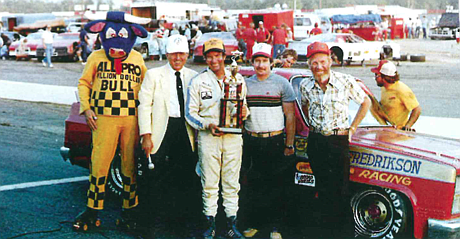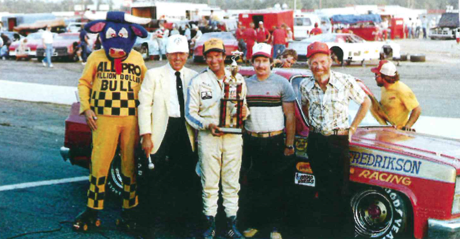Warner Park, Alton Park (Chattanooga Speedway), Soddy-Daisy, Cleveland and East Ridge all had dirt tracks that held regular races on the weekends. Boyd Speedway outside East Ridge has undergone several changes in ownership over the years but still provides an outlet for racers.
Most drivers were amateurs who worked regular jobs during the week while preparing their cars for weekend races.
Robert Richey drove "The Rolling Donut," named after his family's doughnut shop on McCallie Avenue in Highland Park, and is remembered as the winner of a "backward race" at Warner Park on its old horse racing track.
Lake Winnepesaukah, under ownership of founder Carl Dixon, had a dirt track that adjoined the lake. Carl was an expert driver during the 1920s, '30s and '40s before retiring to develop his popular northwest Georgia tourist attraction. A fearless driver, he had competed at the old horse racing track at Warner Park and drove a Hassler Special car to win the 25-mile race during the 1921 Chattanooga Interstate Fair.
Harold's younger brother, Freddy Fryar,"the Beaumont Flyer," started his racing career in Chattanooga at age 14 in the 1950s. Although Harold Fryar Sr. died in an accident on a half-half mile track in 1971, Freddy carried on the family tradition. During his career he won seven NASCAR Series Track Championships and three state championships in Texas, Louisiana and Mississippi. After retiring, he became an instructor at Richard Petty's driving school. In 2012-13, he was inducted into the Georgia, Alabama and Ozarks Racing Halls of Fame for his 826 victories over 37 years.
Raymond "Friday" Hassler, one of the most prominent racers beginning in 1960, was 36 when he died in a crash during his first Daytona 500 qualifying round in 1972. His big victory had come the year before at Bristol Motor Speedway's Volunteer 500 as a relief driver for the eventual winner, Charlie Glotzback. "Friday" had steadily moved up the ranks as a driver and was credited with participating in 135 races during a 10-year period.
Joe Lee Johnson was owner of the Cleveland, Tenn., Speedway. He was the first winner of the World 600 (now Coca-Cola 600) at Charlotte, N.C., and of NASCAR's convertible division. Johnson was featured in a 2014 edition of David McGee's "A History of East Tennessee Auto Racing."
Robert Wayne "Bob" Burcham, the "Bullet from Rossville, Ga.," raced stock cars in the '50s, '60s and '70s. He drove in the Winston Cup Series and finished in the top 10 on several occasions. His best finish was fourth place in a Nashville race in 1974. Inducted in the Tennessee and Georgia Racing Hall of Fame, he died in April 2009 at age 73.
The brilliant NASCAR career of Herbert Grant Adcock, then 39, came to an end Nov. 19, 1989, in a single-car crash at the Atlanta Journal 500 Winston Cup Series. Grant began racing in 1974 under the sponsorship of his family's local Chevrolet dealership. His death due to an improperly mounted racing seat led to new safety regulations on seat mounts. Adcock was dominant in the ARCA class of racing older Winston Cup cars. ARCA's H.G. Adcock Award for sportsmanship is given annually at memorial races in north Georgia and Cleveland, Tenn.
Issues of safety have always been controversial in stock car racing. Wearing seat belts and flame-retardant racing suits are two of many safety features required in recent decades. Many drivers originally resisted safety changes, thinking they distracted from the manly aspects of the sport.
In the '40s, it was the adoption of crash helmets, in the '50s roll bars in the cars, and in the '60s the roll cage. When seat belts were made mandatory in the '50s, several drivers protested and refused to race, claiming belts hindered their ability to escape from cars after a wreck.
Driver defiance lessened after February 2001, when superstar Dale Earnhardt was killed in a crash in the last lap of the Daytona 500 from a "basilar skull fracture," caused by a minor whiplash.
The adoption of several mandatory safety measures may have saved NASCAR from being banned by law and allowed younger drivers to follow the pioneers in this popular sport.
Jerry Summers is an attorney with Summers, Rufolo and Rodgers. For more visit chattahistoricalassoc.org.

